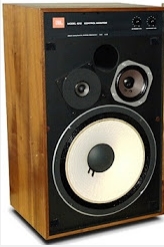Ed's
AV Handbook
Batting practice for the AV Professional
and primer for the novice
Chapter 6 Page 4
The Room, Speaker, & TV
The Speaker System

Speaker facts
A larger full-range speaker is
more fun and better than a smaller speaker. A smaller
speaker shears the bottom two or three octaves of your music
or movie soundtrack. This smaller speaker is analogous
to cropping the bottom third of a photo. More precisely,
downsizing to a smaller speaker is the equivalent of removing
much of the red pigmentation or hue from a treasured
painting's color balance. Smaller speakers do not
reproduce a complete audio picture.
If a speaker accurately reproduces acoustic music, it will also accurately reproduce movie soundtracks. The inverse is not necessarily true. A movie soundtrack typically includes a wealth of artificial sound effects. What is the sound of an actual dinosaur? Although our children may not believe us, we do not, in truth, know. However, music is real. Therefore use music as the reference to judge a speaker's fidelity.
A speaker placed at ear level sounds better as a painting or photo looks best when viewed at eye level.
And proper speaker placement will minimize problems created by room modes.
If a speaker accurately reproduces acoustic music, it will also accurately reproduce movie soundtracks. The inverse is not necessarily true. A movie soundtrack typically includes a wealth of artificial sound effects. What is the sound of an actual dinosaur? Although our children may not believe us, we do not, in truth, know. However, music is real. Therefore use music as the reference to judge a speaker's fidelity.
A speaker placed at ear level sounds better as a painting or photo looks best when viewed at eye level.
And proper speaker placement will minimize problems created by room modes.
Speaker and listener placement
Richard Hardesty 'the Audio
Perfectionist' stated, "The goal of optimally positioning the
speaker and the listener within the room is to make the sound
from the speaker more prominent, and the sound from the room
less prominent." The speaker's distance from a room
boundary is the lead issue. It is inversely related to
the level of the reflected sound's amplitude. That is,
the reflected sound is louder if the speaker is closer to a
boundary, less loud if it is farther away.
Therefore, move the speaker away from the room boundaries, particularly the wall behind the speaker. Three feet is a minimum recommendation. More is better. However, the placement of the speaker should also avoid problem room mode peaks and nulls. The following will guide you through the maze of acoustical obstacles. Begin this project with a sketch of your floor plan.
Therefore, move the speaker away from the room boundaries, particularly the wall behind the speaker. Three feet is a minimum recommendation. More is better. However, the placement of the speaker should also avoid problem room mode peaks and nulls. The following will guide you through the maze of acoustical obstacles. Begin this project with a sketch of your floor plan.
Left and right speaker placement.
I was introduced to the
following procedure many years ago by my late friend Steve
Mounkes.
As will be explained in more detail in Chapter 7 -- this may be the most practical audio application offered on this website.
Calculate, and choose feasible front left and right speaker positions. First, measure the width of the room. Divide this measurement by the values 3, 5, 7, & 9.
Use the results to measure and mark points along the width of the room from the left and then the right corner.
Next, measure the length of the room. Divide by the odd values. Use the result to calculate the room length points.
Mark these points along the room length from the front and then right corner.
Now observe the on-floor coordinates established by the width and length points.
While avoiding equal coordinates, choose a practical pair as positions for your front left and right speaker.
(The home theater layout on the next page outlines this calculation)
As will be explained in more detail in Chapter 7 -- this may be the most practical audio application offered on this website.
Calculate, and choose feasible front left and right speaker positions. First, measure the width of the room. Divide this measurement by the values 3, 5, 7, & 9.
Use the results to measure and mark points along the width of the room from the left and then the right corner.
Next, measure the length of the room. Divide by the odd values. Use the result to calculate the room length points.
Mark these points along the room length from the front and then right corner.
Now observe the on-floor coordinates established by the width and length points.
While avoiding equal coordinates, choose a practical pair as positions for your front left and right speaker.
(The home theater layout on the next page outlines this calculation)
Locate the sweet spot
While avoiding room mode peak
and nulls, place a chair with the front left and right
speakers in an equilateral triangle. This arrangement
creates an inclusive angle of 60 degrees, from the chair to
the front and right speakers.

While seated, listen to a stereo recording. Move the chair slightly forward or back of the initial position. Adjust the cant or focus of the speakers toward the listener. The sweet spot or optimal position is at the point where the stereo recording falls into stereo focus.
The listening position for stereo is also the ideal seating location for a surround sound system. However, additional seating is probably desirable. Therefore, carefully select additional-positions that are comfortable and practical. But avoid room mode peak and nulls. More on this later.
Next step
If your system is stereo music
only with a subwoofer, then move ahead to Subwoofer
Placement.
If it is a stereo audio-video system without a subwoofer, then skip to The TV. If it is exclusively stereo music without a subwoofer, then skip to Loose Ends. If your system is a multi-channel surround system, then continue with the remaining speaker placement instructions on the next page.
If it is a stereo audio-video system without a subwoofer, then skip to The TV. If it is exclusively stereo music without a subwoofer, then skip to Loose Ends. If your system is a multi-channel surround system, then continue with the remaining speaker placement instructions on the next page.
Copyright 2007 Txu1-598-288 Revised 2025
Site Menu
Home
Table of
Contents
Handbook Chapters
1 AV
Terms
2 AV Physics
3 Sound Reproduction
4 Video Reproduction
5 The AV System Sequence
6 The Room, Speaker, & TV
7 Acoustical Strategy - Small Room
8 Home Theater by Design
9 AV Sales Training
10 AV Business & Marketing
Contact
About
